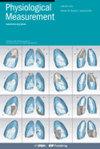如何量化试图入睡时的困倦感?
IF 2.3
4区 医学
Q3 BIOPHYSICS
引用次数: 0
摘要
背景嗜睡评估工具大多是为检测睡眠不足和一些疾病情况下的嗜睡程度而开发的。目的我们研究了客观嗜睡指数是否可用于检测多导睡眠监测仪监测的睡眠尝试过程中的嗜睡水平波动,即在整个睡眠尝试过程中缺乏嗜睡水平自我报告的情况下。为了计算两个客观嗜睡指数,对每条记录的 30 秒时程的脑电图(EEG)频谱进行平均,将其归入 5 个睡眠-觉醒阶段之一,并使用觉醒状态嗜睡子状态的频率加权曲线或脑电图频谱变化的第 2 主成分中每个频率的负荷量进行评分(分别为嗜睡评分或 PC2 评分)。主要结果我们发现,这两个客观嗜睡指数在分配到唤醒阶段的时程中出现的统计学意义上的显著波动,可以通过卡罗林斯卡嗜睡量表 9 级评分所评估的主观嗜睡程度的口头锚定变化来描述。本文章由计算机程序翻译,如有差异,请以英文原文为准。
How to quantify sleepiness during an attempt to sleep?
BACKGROUND
Sleepiness assessment tools were mostly developed for detection of an elevated sleepiness level in the condition of sleep deprivation and several medical conditions. However, sleepiness occurs in various other conditions including the transition from wakefulness to sleep during an everyday attempt to get sleep.
OBJECTIVE
We examined whether objective sleepiness indexes can be implicated in detection of fluctuations in sleepiness level during the polysomnographically-monitored attempt to sleep, i.e., in the absence of self-reports on perceived sleepiness level throughout such an attempt.
APPROACH
The polysomnographic signals were recorded in the afternoon throughout 106 90-min napping attempts of 53 university students (28 females). To calculate two objective sleepiness indexes, the electroencephalographic (EEG) spectra were averaged on 30-s epochs of each record, assigned to one of 5 sleep-wake stages, and scored using either the frequency weighting curve for sleepiness substate of wake state or loadings of each frequency on the 2nd principal component of variation in the EEG spectrum (either sleepiness score or PC2 score, respectively).
MAIN RESULTS
We showed that statistically significant fluctuations in these two objective sleepiness indexes during epochs assigned to wake stage can be described in terms of the changes in verbally anchored levels of subjective sleepiness assessed by scoring on the 9-step Karolinska Sleepiness Scale.
SIGNIFICANCE
The results afford new opportunities to elaborate importance of intermediate substates between wake and sleep states for sleep-wake dynamics in healthy individuals and patients with disturbed sleep.
求助全文
通过发布文献求助,成功后即可免费获取论文全文。
去求助
来源期刊

Physiological measurement
生物-工程:生物医学
CiteScore
5.50
自引率
9.40%
发文量
124
审稿时长
3 months
期刊介绍:
Physiological Measurement publishes papers about the quantitative assessment and visualization of physiological function in clinical research and practice, with an emphasis on the development of new methods of measurement and their validation.
Papers are published on topics including:
applied physiology in illness and health
electrical bioimpedance, optical and acoustic measurement techniques
advanced methods of time series and other data analysis
biomedical and clinical engineering
in-patient and ambulatory monitoring
point-of-care technologies
novel clinical measurements of cardiovascular, neurological, and musculoskeletal systems.
measurements in molecular, cellular and organ physiology and electrophysiology
physiological modeling and simulation
novel biomedical sensors, instruments, devices and systems
measurement standards and guidelines.
 求助内容:
求助内容: 应助结果提醒方式:
应助结果提醒方式:


